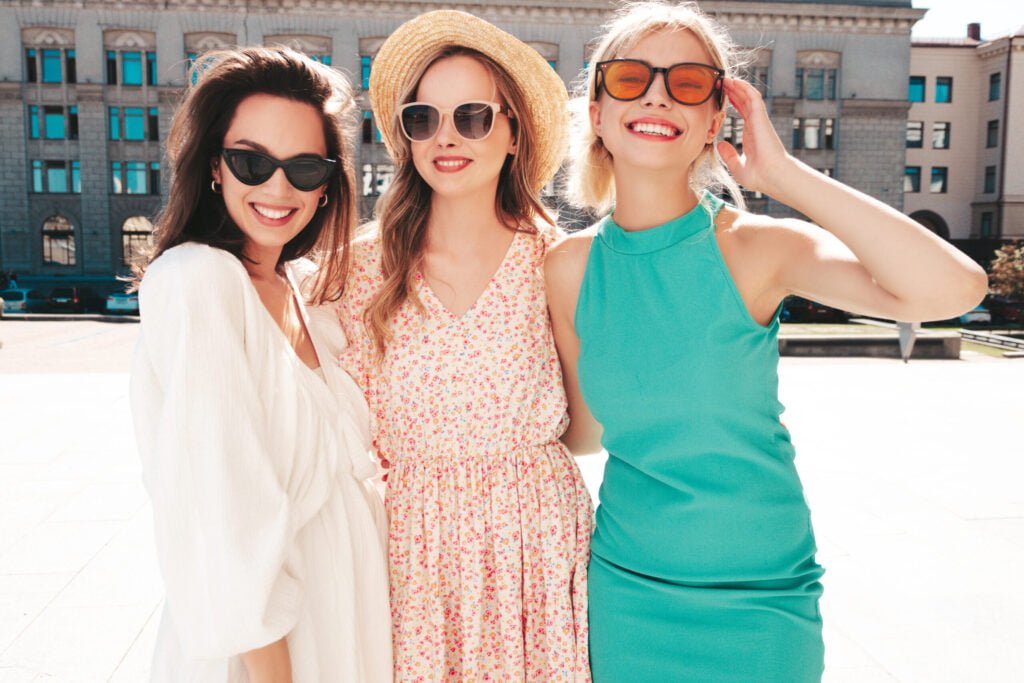In the vivid tapestry of history, fashion has always played a defining role, reflecting cultural, social, and even political shifts. From flapper dresses of the 1920s to the evolving modern styles we see today, the influence is palpable. Even the diverse range of dresses Canada has to offer showcases the global interplay of trends, drawing inspiration from various eras. This article journeys through time, revisiting iconic women’s fashion moments that have helped shape our current sartorial landscape.
The 1800s: Victorian Elegance and Reform
The 1800s witnessed vast shifts in fashion, largely influenced by the societal constructs of the Victorian era. The early part of the century was dominated by the Regency style, which was inspired by classical antiquity. Women’s gowns had high waistlines, right below the bust, creating a long, slender silhouette. This was a distinct move away from the tight corsets and fuller skirts of the previous era.
As the century progressed, the crinoline became a staple in women’s fashion. It was a structured cage worn under a skirt to make it stand out and appear fuller. Initially made from horsehair (from which it gets its name), the crinoline evolved with the introduction of steel hoops, making skirts expand to unprecedented widths.
However, the latter part of the 1800s brought with it a change, replacing the voluminous crinoline with the bustle, a padded undergarment worn at the back of the skirt. This emphasized the fullness at the rear while the front of the skirt became more streamlined.
Parallel to these styles, a significant fashion reform movement was underway, led by women who found the tight lacing of corsets and cumbersome skirts restrictive and unhealthy. The Rational Dress Society was founded with the aim to promote more comfortable and functional clothing for women. This saw the introduction of ‘reform clothing’ such as the “Bloomer costume”, which was essentially a tunic worn over loose trousers gathered at the ankle.
The Late 1800s: The Aesthetic Movement and Artistic Dress

The Aesthetic Movement in the late 1800s was a reaction against mass-produced clothing and the constraints of tight-lacing and structured garments. It sought inspiration from nature, art, and history. The movement, influenced by artists and writers, emphasized the importance of beauty and art in everyday life.
For women, this meant a return to simpler, more flowing lines in clothing, drawing inspiration from medieval, Renaissance, and classical Grecian robes. The garments were often in muted shades and loose-fitting, allowing for more freedom of movement and breathing. The Aesthetic dress was not just a fashion statement but also a symbol of a woman’s alignment with progressive ideas.
The early 1900s: The Edwardian Era and the Prelude to Change
The turn of the century, often referred to as the Edwardian era, was a time of opulence and luxury in fashion. With King Edward VII on the British throne, the period was marked by elegance and a continuation of Victorian principles, but with its own unique touch.
The S-curve silhouette became popular, with corsets pushing the bust forward and the hips back, creating an ‘S’ shape. Delicate lace, chiffon, and silks were the materials of choice, creating a soft, ethereal look. Large hats adorned with feathers, ribbons, and flowers became the crowning glory for many women during this time.
However, the undercurrents of change were palpable. As the world moved toward the First World War, there was a noticeable shift in the fashion landscape. Skirts began to rise, and a more practical approach to women’s clothing was evident, setting the stage for the revolutionary changes in the 1920s.
The Influence of Global Expeditions and Exoticism
The late 19th and early 20th centuries saw an increase in global expeditions, archaeological discoveries, and a fascination with the ‘exotic’. The discovery of Tutankhamun’s tomb in 1922, for instance, brought Egyptian aesthetics into popular fashion. This was evident in the use of motifs, patterns, and accessories reminiscent of these foreign cultures.
Similarly, Orientalism, or the Western fascination with the East (including Middle Eastern, South Asian, and East Asian cultures), heavily influenced fashion. Kimono-style robes, turbans, and other traditionally ‘Eastern’ elements were incorporated into Western fashion, creating a blend of styles and aesthetics.
This era was not just about imitating these cultures but also a reflection of the larger world becoming more interconnected. The incorporation of global elements into fashion was a testament to the broader cultural exchanges happening during this time.
The 1920s: The Roaring Flapper
In the wake of World War I, women began to break away from the confines of earlier Edwardian styles. The 1920s introduced the flapper dress, which became the emblem of the decade. Hemlines rose, waistlines dropped, and the silhouette became more streamlined. This shift represented the newfound freedom and independence women were beginning to enjoy. Along with the iconic flapper dresses and party dresses were bobbed hairstyles, strings of pearls, and the cloche hat – a bell-shaped hat that snugly fit around the head. The carefree spirit of the time was palpable, and women’s fashion was a powerful reflection of that ethos.
The 1930s: Hollywood Glamour
The 1930s brought a touch of class and sophistication. Influenced by Hollywood, evening gowns became more glamorous, emphasizing the natural curves of the body. Bias-cut dresses, which utilized a diagonal cut of the fabric, created a figure-hugging look. Silky fabrics like satin and lamé became popular choices for these gowns. While daywear remained modest, it incorporated softer fabrics and floral patterns, indicating a move towards more comfortable yet refined clothing.
The 1940s: War and Restrained Elegance
The 1940s were marked by World War II, which greatly impacted the fashion industry. Materials like silk, nylon, and various metals were rationed for the war effort. As a result, dresses and skirts became shorter and simpler. Yet, women found ways to express themselves despite the restrictions. Strong shoulders became a signature look of the 40s, often highlighted by shoulder pads. The cinched waist and A-line skirts emerged as staple features, celebrating the feminine form even amidst adversity.
The 1950s: The Age of Opulence
Post-war optimism in the 1950s brought an explosion of colors, patterns, and textures. Christian Dior’s ‘New Look’ became iconic, characterized by a tiny waist, full skirt, and mid-calf length, echoing a return to femininity and luxury after the war’s austerity. This decade also saw the rise of pencil skirts, twinsets, and petticoats. Moreover, for the younger generation, poodle skirts and saddle shoes became the rage. Hollywood stars like Marilyn Monroe and Audrey Hepburn further defined and popularized the fashion of this decade
The 1960s: Revolution and Mod Style
The 1960s were characterized by youth-led fashion and a drive for change. London became the fashion capital of the world, with designers like Mary Quant leading the mod movement. Mini skirts, shift dresses, and graphic prints became staples. Bright colors, geometric patterns, and PVC boots and accessories further emphasized the decade’s boldness. Moreover, the hippie movement brought with it flared jeans, tie-dye, and bohemian styles, showcasing the era’s diverse and eclectic fashion sensibilities.
The 1970s: Disco Fever and Bohemian Vibes
The 1970s, while continuing some of the hippie styles from the late 60s, introduced its own distinct trends. Bell-bottom jeans, platform shoes, and jumpsuits symbolized the disco era. The fashion was glitzy, colorful, and larger than life. On the other hand, peasant blouses, maxi skirts, and earthy colors represented the bohemian side of the 70s. The decade’s fashion was versatile, providing ample room for personal expression.
The 1980s: Power Dressing and Pop Culture
The 80s was the era of extravagance. Big hair, shoulder pads, and bold colors defined the decade. Power dressing became a significant trend, with women donning pantsuits, high heels, and large accessories to make powerful sartorial statements in the professional world. The influence of pop culture was undeniable, with icons like Madonna and Cyndi Lauper setting trends. Bright neon colors, leg warmers, and oversized tops became synonymous with 80s style.
The 1990s: Minimalism and Grunge

In contrast to the 80s, the 90s saw a shift towards minimalism. Calvin Klein and Kate Moss introduced the world to the minimalist chic look, characterized by simple lines and neutral colors. Yet, grunge, inspired by bands like Nirvana, also became a defining style. Flannel shirts, ripped jeans, and combat boots became staples for many. The decade was a mix of refined simplicity and raw edge.
2000s-Present: A Global Melting Pot
The new millennium ushered in an era where fashion became more globalized. Influences from different cultures began merging, creating a rich tapestry of styles. Trends like athleisure, where sportswear meets daily fashion, gained popularity. Sustainability and eco-friendly fashion have also taken center stage, with consumers becoming more conscious of their choices. Moreover, the rise of digital platforms has made fashion more accessible, leading to rapid trend cycles and a more interconnected global fashion community.
Reflecting on the Journey
Fashion, in its essence, is more than just clothing. It’s a reflection of the times, capturing the essence of each era. As we’ve seen, every decade has its defining moments, shaped by societal changes, world events, and individual expressions. Women’s fashion, in particular, tells a captivating story of empowerment, resistance, and evolution. Whether we’re reminiscing about past trends or anticipating the future, fashion remains a powerful medium to understand our world and our place in it.











